Table of Contents
Communication System Important Questions for CBSE Class 12 Physics Modulation
1.Modulation Modulation is the process of variation of some characteristics of a carrier wave in accordance with the instantaneous value of a modulating signal.

3.Types of modulations
(i) Amplitude modulation (ii) Frequency modulation
(iii) Phase modulation (iv)Pulse modulation
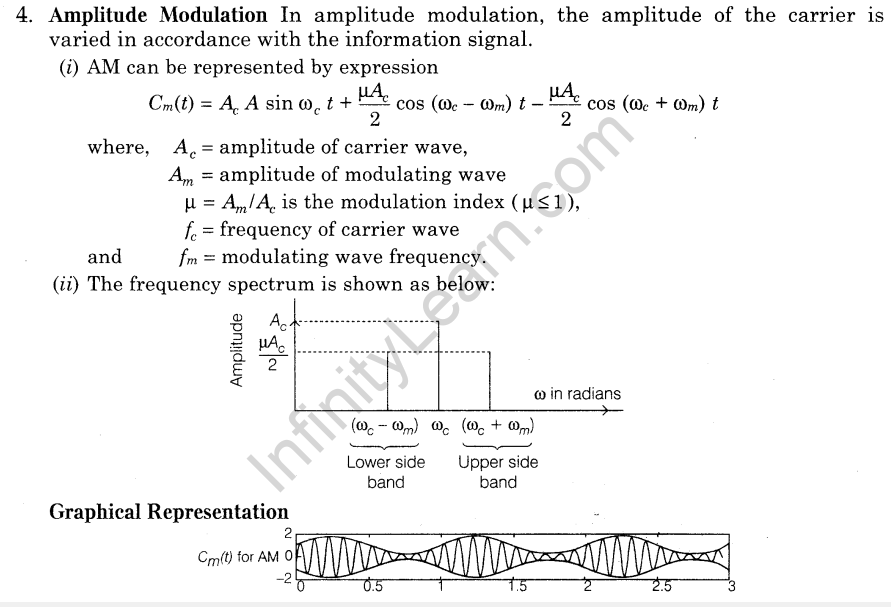
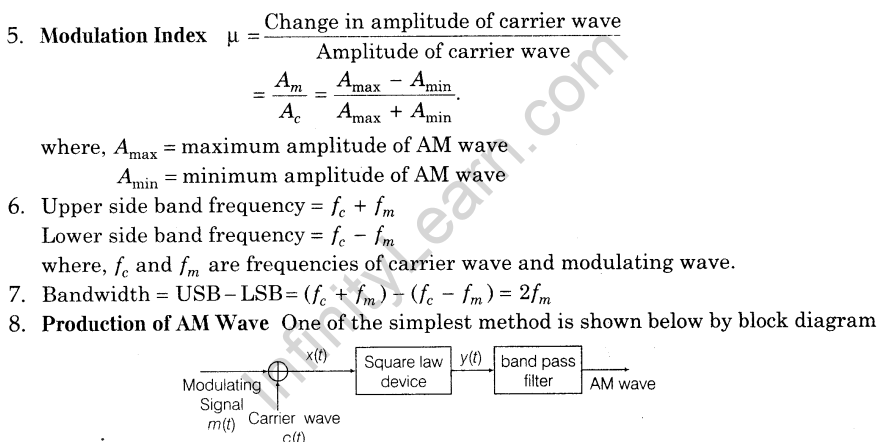
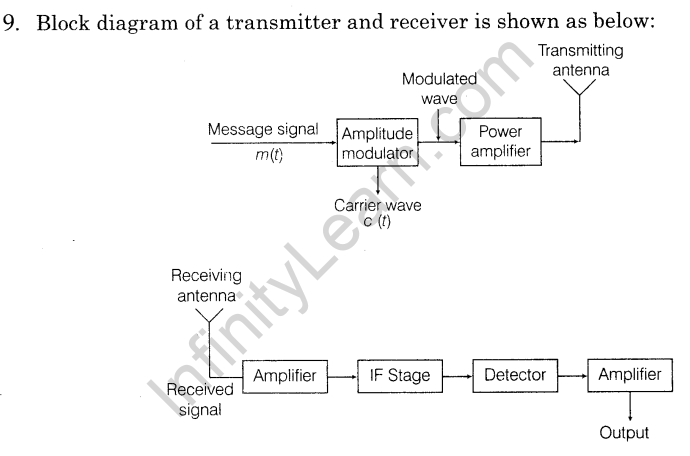

11.Types of pulse modulation
(i) PAM (Pulse Amplitude Modulation) (ii) PDM (Pulse Duration Modulation)
(iii) PPM (Pulse Position Modulation) (iv) PCM (Pulse Code Modulation)
12.Internet It is a network of computers, printers disk drives or other devices, connected in a network topology that allows the device to communicate.
13.Local Area Network In is a group of computers and associated devices that share a common communication line or wireless link. Typically, connected device share the resources of a single processor or server within a small geographic area.
14.Wide Area Network A Wide Area Network (WAN) is a network that covers a broad area (i. any tele-communications network that links across metropolitan, regional, national or international boundaries) using leased telecommunication lines.
15.Client Computer Every computer that extracts information from a server is called a client computer.
16.Webpage A hypertext decument connected to the world wide area is known as webpage. It may contain text, videos, etc.
17.Website A location connected to the internet that maintains one or more web pages.
18.Internet Service Providers An Internet Service Provider (ISP) is an organisation that provide services for accessing using or participating in the internet.
19.People use internet for many purposes like searching and viewing information on any topic of interest for sending electronic mails, for e-banking, e-shopping, e-booking, etc.
20.Electronic mail Electronic mail is the exchange of computer-stored messages by telecommunication.
21.Mobile telephony is the provision of telephone services to phones which may move around freely rather than stay fixed in one location. Mobile phones connect to a terrestrial cellular network of base stations, whereas satellite phones connect to orbiting satellites.
22.A cellular network or mobile network is a wireless network distributed over land areas called class, each served by at least one fixed location transceiver, known as a cell site or base station.
23.All network related works including handling of all the incoming and outgoing calls are managed by a central control room called Mobile.
Telephone Switching Office (MTSO)
24.A telephone numbering plan is a type of numbering schemes used in telecommunication to assign telephone numbers to subscriber telephones or other telephony endpoints.
25. 1G is the first generation of mobile network which are based on analog radio signal.
2 G is based on narrow band digital signal. 3 G is the increased data transfer speed.
4 G is provide a high-speed internet facility.
26.Global positioning system is a space based satellite navigation system that provides location and time information in all weather conditions.
27.Twelve number of satellites is required for correct and accurate location indentification in the global positioning system.
Previous Years Examination Questions
1 Mark Questions
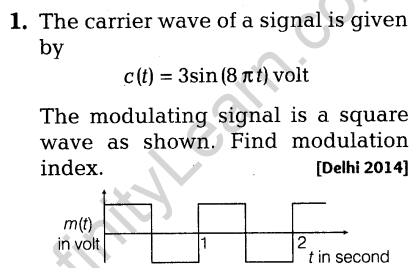
Ans.
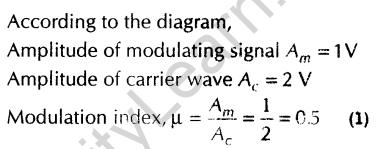
2.Why do we need a higher bandwidth for transmission of music compared to that for commercial telephonic communication? [Delhi 2009]
Ans.The range of frequencies of music is higher than commercial telephone conversation and therefore, greater bandwidth is needed for music. Also, it is free from noise.
3.Identify the part X and Y in the following block diagram of a generalised communication system. [Delhi 2008C]

Ans. According to question figure,
X: Information source.
Y: Communication channel
2 Marks Questions
4.Define the term modulation. Draw a block diagram of a simple modulator for obtaining AM signal. [Foreign 2014]
Ans. Modulation is the process in which low frequency message signal is superimposed on high frequency carrier wave so that they can be trasmitted over long distances. The block diagram for a simple modulator for obtaining AM signal is shown as below:

5.A message signal of frequency 10 kHz and peak voltage 10 V is used to modulate a carrier of frequency 1 MHz and peak voltage 20 V. Determine
- the modulation index
- the side bands produced. [Delhi 2013C]
Ans.

6.In the block diagram of a simple modulator for obtaining an AM signal shown in the figure, identify the boxes A and B. Write their function.

Ans.
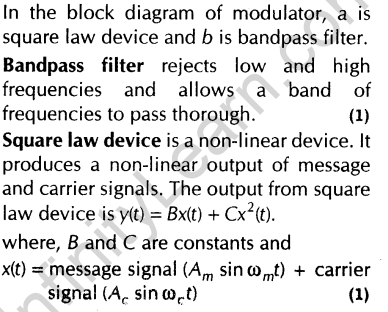
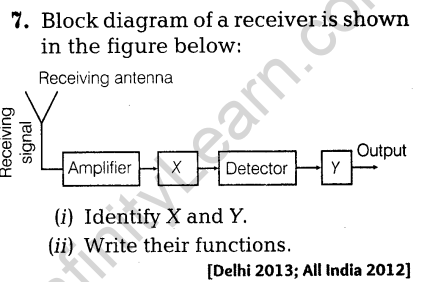
Ans. From the given block diagram of demodulation of a typical receiver, we can conclude the following,
(i) X represents Intermediate Frequency (IF) stage while Y represents an amplifier.
(ii) At IF stage, the carrier frequency is changed to a lower frequency and in this process, the modulated signal is detected while the function of amplifier is to amplify the detected signal which may not be strong enough to be made use of and hence is required.
8.Figure shows a block diagram of a transmitter identify the boxes X and Y and write their functions. [Foreign 2012]

Ans.
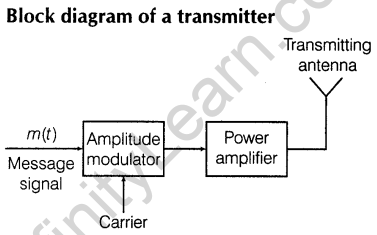
Modulator Since, the frequency range of signal is quite low and it is associated with very small amount of energy. It dies out very soon if transmitted as such.
So, it is modulated by mixing with very high frequency waves called carrier waves. This is done by modulator power. Amplifier Since, the signal gets weaken after travelling through long distances it cannot be transmitted as such.
Thus, we use a power amplifier to provide it necessary power before feeding the signal to the transmitting antenna.
9.A carrier wave of peak voltage 18 V is used to transmit a message signal. Calculate the peak voltage of the modulating signal in order to have a modulation index of 50%. [Delhi 2012]
Ans.
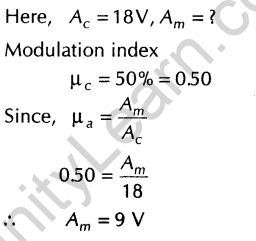
10.For an amplitude modulated wave, the maximum amplitude is found to be 10 V while the minimum amplitude is 2 V. Calculate the modulation index. Why is modulation index generally kept less than one? [Foreign 2011]
Ans.
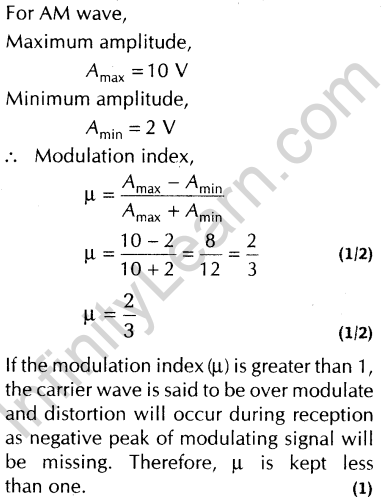
11. For an amplitude modulated wave, the maximum amplitude is found to be 12 V while minimum amplitude is 2 V the modulation index. Why is modulation index generally kept less than One? [Foreign 2011]
Ans. Refer to ans .10
12.(i) Define modulation index.
(ii) Why is the amplitude of modulating signal kept less than the amplitude of carrier wave? [Delhi 2011]
Ans.
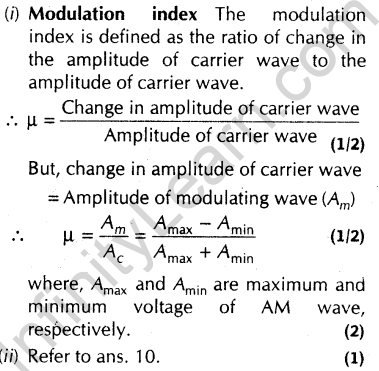
13.Write two factors justifying the need of modulating a signal. A carrier wave of peak voltage 12 V is used to transmit a message signal. What should be the peak voltage of the modulating signal in order to have a modulation index of 75%? [Ail India 2010]
Ans.

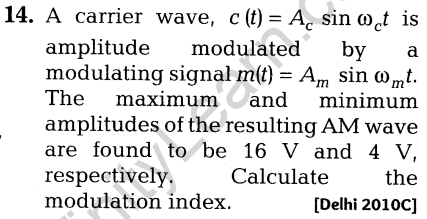
Ans.
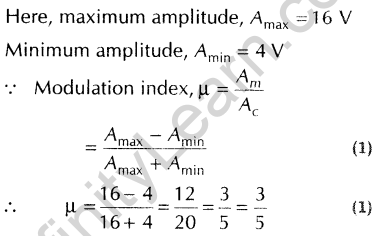
15. Write two factors justifying the need of modulation for transmission of a signal. [All India 2009]
Ans. The needs of modulation for transmission of a signal are given as below:
(i) The transmission of low frequency signal needs antenna of height 4-5 km which is impossible to construct. So, there is a need to modulate wave in order to reduce the height of antenna to a reasonable height.
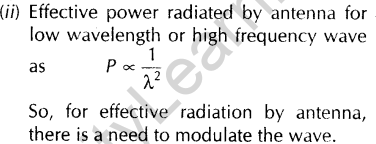
16.A message signal of frequency 10 kHz and peak voltage of 10 V is used to modulated frequency of 1 MHz and peak voltage of 20 V. Determine the
- modulation index
- the sidebands produced [All India 2009C]
Ans.
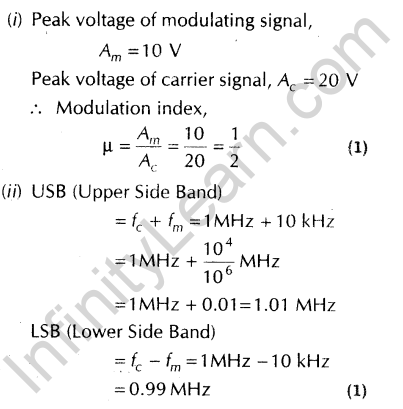
17.Draw a block diagram of a simple amplitude modulation. Explain briefly how amplitude modulation is achieved? [HOTS; All India 2008]
Ans.
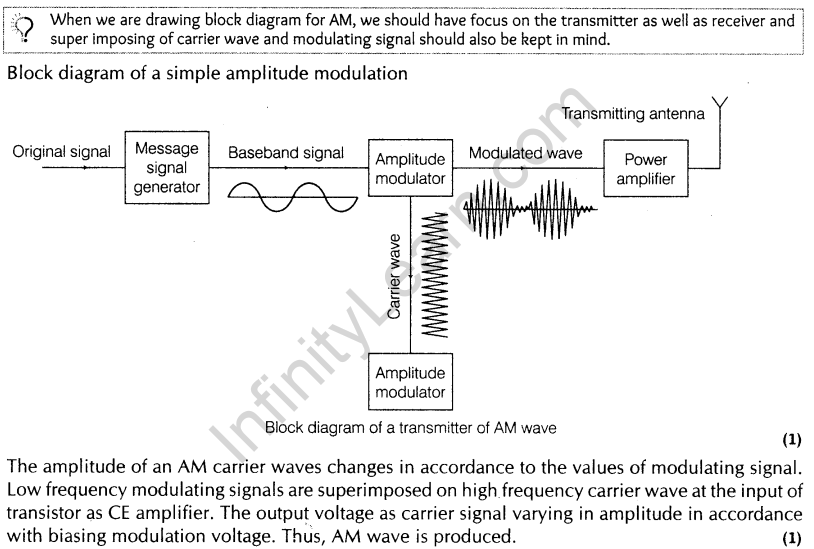
3 Marks Questions
18.Write two basic modes of communication. Explain the process of amplitude modulation.
Draw a schematic sketch showing how amplitude modulated signal is obtained by superposing a modulating signal over a sinusoidal carrier wave. [All India 2014]
Ans.
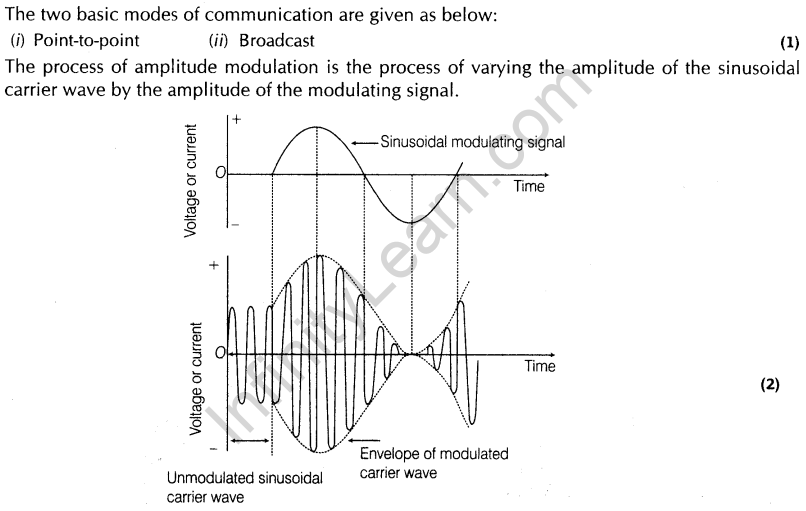
19. Arnab was talking on his mobile to his friend for a long time. After his conversation was over, his sister Anita advised him that if his conversation was of such a long duration, it would be better to talk through a land line.
- Why is it considered harmful to use a mobile phone for a long duration?
- Which values are reflected in the advice of his sister Anita?
- A message signal of frequency 10 kHz is superimposed to modulate a carrier wave of frequency 1 MHz. Determine the sidebands produced. [All India 2014c]
Ans.
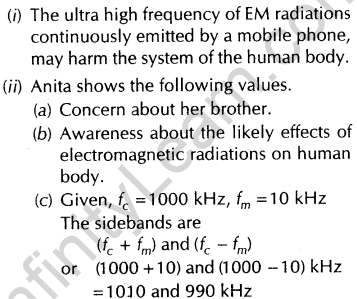
20.What is meant by detection of a modulated signal? Draw block diagram of a detector for AM waves and state briefly showing the waveforms, how the original message signal is obtained. [Delhi 2013c]
Ans.
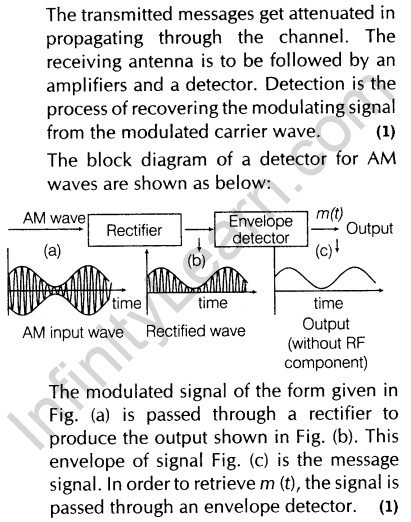
21.Write three important factors which justify the need of modulating a message signal. Show diagrammatically how an amplitude modulated wave is obtained when a modulating signal is superimposed on a carrier wave. [Delhi 2013]
Ans.
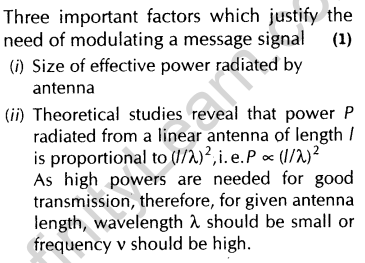
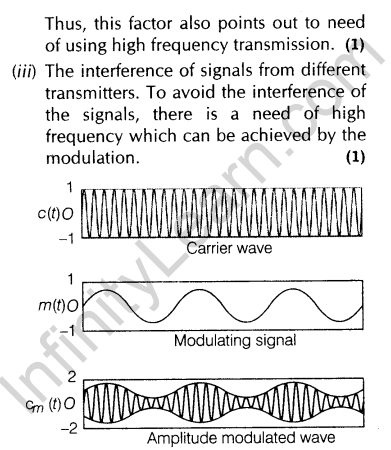
22.Define modulation index. Give its physical significance. For an amplitude modulated wave, the maximum amplitude is found to be 10 V while the minimum amplitude is 2 V. Determine the modulation index p. [Foriegn 2012]
Ans.
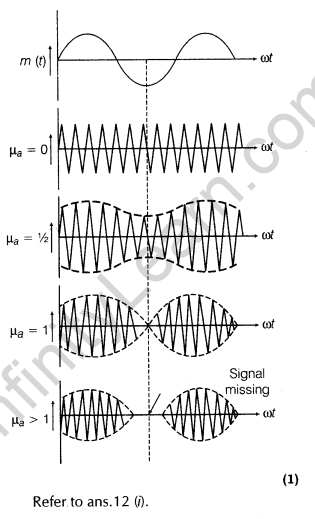
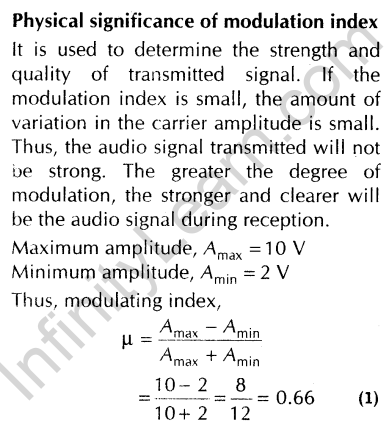
23.Write briefly any two factors which demonstrate the need for modulating signal. Draw a suitable diagram to show amplitude modulation using a sinusoidal signal as the modulating signal. [HOTS; Delhi 2012, All India 2011]
Ans.

24.

(ii) Audio signals converted into an electromagnetic wave are not directly transmitted.
(iii) The amplitude of a modulating signal is kept less than the amplitude of carrier wave.
Ans.


25. State the two main reasons explaining the need of modulation for transmission of audio signals.
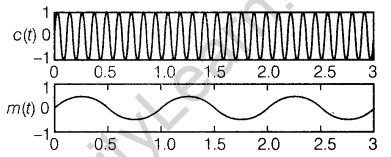
The diagrams given above show a carrier wave c (f), that is to be (amplitude) modulated by a modulating signal m{t). Draw the general shape of resulting AM wave. Define its modulation index. [All India 2010C]
Ans.

26.Draw a plot of the variation of amplitude versus co for an amplitude modulated wave. Define modulation index. State its importance for effective amplitude modulation. [Delhi 2008].
Ans. For importance of effective amplitude modulation Refer to ans. 15.
27.Draw a block diagram of a detector for an amplitude modulated signal explaining briefly the function of each of its components. [Delhi 2008C]
Ans.
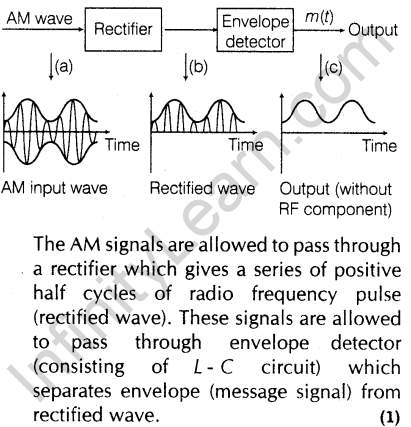
28.Draw a block diagram of a simple modulator for obtaining an amplitude modulated (AM) signal explaining briefly the function of each of its components. [HOTS; Delhi 2008C]
Ans.Figure refer to ans. 17
For the function of each of its component Refer to ans. 27.







